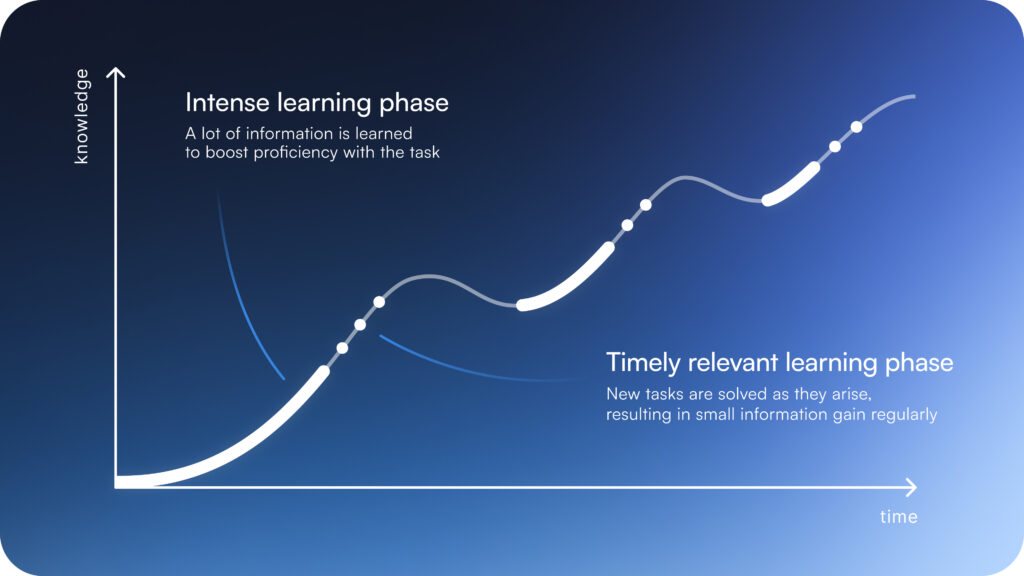The 5 moments of need model focuses on providing timely and contextually relevant learning experiences, which support employees through every phase of their interaction with new software – from initial exposure to mastery and troubleshooting. By understanding and applying this model, decision-makers can significantly enhance the return on investment (ROI) in technology, driving user competence and overall organizational success.
What is the 5 moments of need model?
The 5 moments of need is a framework specifically designed to enhance learning and support throughout the software adoption process. This model is particularly crucial in the complex environment of enterprise software systems, where users must navigate through various stages of learning and application. Here’s a breakdown of the five critical moments where targeted intervention can dramatically improve user engagement and proficiency:
- New: When learners first encounter a new tool or system, they require foundational knowledge to get started. This stage focuses on delivering initial instructions and essential functionalities.
- More: Once users grasp the basics, they often seek to broaden their understanding. At this stage, software training aims to expand their skills and deepen their knowledge of the system.
- Apply: This critical moment involves applying learned skills in real-world scenarios. Users need ongoing support to make informed decisions and use the software effectively in their daily tasks.
- Solve: When users face issues or challenges, immediate and specific assistance is required to resolve these problems without disrupting the workflow. This support ensures continuity and efficiency.
- Change: Software systems frequently update and evolve. Users must adapt to these changes swiftly, necessitating quick access to new learning resources that cover updated functionalities and processes.
Each of these moments is an opportunity to integrate learning directly into the workflow, enhancing both the retention and application of knowledge.

Workflow learning recognizes that knowledge acquisition isn’t a one-time event, but a continuous process that evolves alongside the demands of our tasks. Integrating learning directly into the workflow ensures that employees are always equipped with the right knowledge at the right time, maximizing their productivity, efficiency, and the overall return on investment for the organization.
The strategic importance of the 5 moments of need in software adoption
Implementing the 5 moments of need model in enterprise software adoption is a learning strategy that can prove critical business strategy, as it aligns learning with the actual workflow and real-time demands of the workplace.
1. Efficiency
By integrating learning directly into the work process, the model minimizes disruptions and downtime. This efficient approach accelerates user proficiency and confidence in new software tools, directly reducing the time to value from technology investments.
2. Productivity
Targeted support in the ‘Apply,’ ‘Solve,’ and ‘Change’ moments helps users maintain or even increase productivity, despite the potential challenges posed by new or evolving software environments. This is crucial in maintaining uninterrupted business operations and achieving strategic business outcomes.
3. Adaptability
In an era where technology evolves rapidly, having a workforce that can quickly adapt to new tools and processes is invaluable. The 5 moments of need model fosters an environment of continuous learning and adaptability, preparing employees to handle future changes and challenges more effectively.
Investing in a learning model that supports these moments means creating a more agile, knowledgeable, and effective workforce. Such investments contribute to immediate operational success, long-term sustainability, and competitive advantage in a digital-first world.
Using the EnABLE methodology
To systematically achieve these strategic benefits, it’s essential to adopt a structured approach to implementing the 5 moments of need model.
This is where the EnABLE methodology comes into play. Developed specifically to support the deployment and scaling of the 5 moments of need framework, EnABLE stands for Engage, Analyze, Build, Leverage, and Evaluate. Each phase is designed to ensure that learning strategies are not only aligned with business goals but are also effectively executed to deliver measurable outcomes:
- Engage: This phase involves securing executive buy-in and aligning the learning initiatives with strategic business objectives. Engaging key stakeholders early ensures that the learning interventions are supported at the highest level and are clearly linked to organizational goals.
- Analyze: Here, the focus is on identifying specific needs and gaps within the existing workflows where targeted learning interventions can be most beneficial. This detailed analysis informs the development of solutions that are perfectly tailored to the real challenges faced by employees.
- Build: The solutions conceptualized in the previous phases are developed and implemented. This involves creating and integrating learning resources that users can access right within their workflow, ensuring minimal disruption and maximum applicability.
- Leverage: During this phase, the solutions are rolled out across the organization, and their integration into daily workflows is supported and monitored. This ensures that the learning interventions are not only adopted but also adapted as necessary to fit the evolving business and technological landscape.
- Evaluate: The final phase involves measuring the impact of the learning interventions on performance and productivity. Regular assessments help in refining the learning solutions and demonstrating their ROI, which is critical for sustaining support from stakeholders.
By integrating the EnABLE methodology, organizations can ensure that their investment in the 5 moments of need model translates into tangible business benefits, ultimately leading to a more agile, knowledgeable, and effective workforce. This structured approach not only reinforces the strategic importance of adaptive learning systems but also provides a clear roadmap for their successful implementation.

Implementing the 5 moments of need model in your organization
Implementing the 5 moments of need model within an organization requires a deliberate and structured approach that ensures every phase is impactful and aligns with business objectives.
Assessment of learning needs
Begin by evaluating your existing training programs to identify where they currently fall short in supporting the 5 moments of need. This assessment should involve a comprehensive analysis of the challenges employees face at each stage of their interaction with new software. Understanding these challenges is crucial to tailor your training approach effectively.
Deep dive into each moment of need
To effectively address the needs of your organization, it’s essential to understand and implement strategies tailored to each of the five moments:
- New: Introduce foundational knowledge for new tools or systems through structured onboarding sessions. Ensure these sessions are mandatory and include interactive elements to engage learners from the start.
- More: Once users are comfortable with the basics, provide opportunities for further learning. This can include advanced training modules and workshops that deepen their understanding and enhance their skills.
- Apply: Support users in applying their knowledge through real-world scenarios. This could involve simulations or real-time problem-solving exercises embedded within the work environment, helping users to practice and perfect their skills.
- Solve: Establish a rapid-response support system to address issues as they arise. This could include a dedicated helpdesk, on-demand access to troubleshooting guides, or instant chat support within the software itself.
- Change: Prepare users for system updates or process changes through quick-access training modules and update briefings. This ensures users are always up-to-date and can adapt quickly to changes.
Stakeholder engagement
After assessing the learning needs and understanding how to address each moment, engage with IT, HR, and department heads to ensure the learning strategy is comprehensive and integrated across all aspects of the business. Their insights will help tailor the learning experiences to be as relevant and practical as possible, enhancing their effectiveness and adoption.
Technology integration
Deploy innovative learning technologies that facilitate seamless learning experiences. Digital adoption platforms like ClickLearn are pivotal, as they allow for the creation, management, and delivery of dynamic learning content right within the software environment. This ensures that help is available at the moment of need – critical for the ‘Apply,’ ‘Solve,’ and ‘Change’ moments.
Monitor and optimize
Implement a system to continually collect feedback from users and monitor their performance. This data is invaluable for adjusting learning strategies and materials in real-time. By being responsive, you ensure that the training remains relevant and effectively supports all five moments of need.
Success stories and case studies
Finally, highlight examples from within the organization or similar industries where the implementation of this model has led to successful software adoption and performance improvement. These stories validate the approach and inspire confidence in the strategy.

Transform software adoption in your enterprise with the 5 moments of need framework
Integrating AI-powered tools like ClickLearn into your enterprise software adoption strategy can redefine how learning and support are delivered. As an AI-powered Digital Adoption Platform (DAP), ClickLearn supports every moment of the learning journey, ensuring that every employee is equipped to handle the challenges of tomorrow’s business environment with today’s technologies.
Cultivating a learning culture through innovative performance support
Adopting tools like ClickLearn facilitates the embedding of a continuous learning culture within the workplace. Performance support, delivered through AI-powered tools, allows learning to occur in the flow of work, enabling employees to access information and solve problems in real-time without stepping away from their tasks.
This approach not only improves efficiency but also fosters a culture of self-directed learning and problem-solving among the workforce. For instance, ClickLearn can provide on-screen guidance and step-by-step instructions directly within the software applications employees use, promoting a seamless learning experience that supports the ‘Apply’ and ‘Solve’ moments effectively.
By promoting learning in the flow of work, organizations create a more dynamic and responsive environment where employees are continually developing their skills and knowledge. This not only boosts individual performance but also contributes to organizational agility and resilience.
Connecting learning outcomes to business metrics
To demonstrate the ROI of integrating learning technologies like ClickLearn, it’s essential to connect learning outcomes with tangible business metrics. Begin by identifying key performance indicators (KPIs) such as increased productivity, reduced error rates, faster onboarding times, or improved customer satisfaction. Use these metrics to track the effectiveness of your learning interventions.
For example, measure the decrease in support tickets or the improvement in task completion time before and after implementing ClickLearn. Regularly review these metrics and adjust your learning strategies as needed to maximize outcomes. This data-driven approach ensures that your investment in learning and development is aligned with business goals and delivers measurable results.
By implementing a strategic learning framework supported by advanced tools and linked to clear business outcomes, your organization can significantly enhance software adoption rates and overall operational efficiency. This transformative approach not only empowers employees but also drives substantial business growth.

